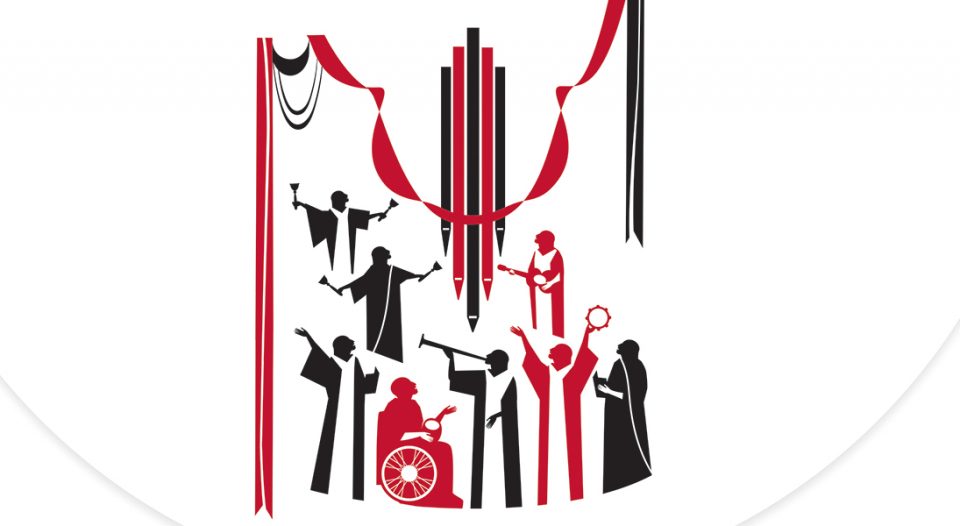Editor’s note: Martin Luther famously said, “Next to the Word of God, music deserves the highest praise” (Luther’s Works, Vol. 53). The ELCA still holds tightly to Luther’s understanding. In this series, we’re exploring Lutheran music throughout history, the importance of music to the Lutheran faith and how that tradition continues today across styles and expressions
The central role of assembly song in Lutheran worship was established early in the Reformation. Though Catholic congregational singing was practiced in some German cities and towns, Martin Luther and his fellow reformers—assisted by the printing press and a growing supply of locally produced hymnals—helped popularize this practice.
An able musician, Luther encouraged fellow authors and composers to craft texts and melodies that would both teach and edify congregations in their native language. In 1523, he wrote to a friend: “As you have truly been given both fluency and elegance in the German language, perfected through much practice, I ask that you work with us in this matter and try to transform some psalm or other into a song” (Worship Wars in Early Lutheranism, Oxford University Press, 2004).
Luther and Philipp Melanchthon also recognized the need for an educational system that would train pastors, musicians, authors and composers to serve future generations of Lutherans. Accordingly, they established schools founded upon the classic liberal arts model, a curriculum wherein music was essential.
Luther was adamant and characteristically blunt in his collection Table Talk: “Necessity demands that music be kept in the schools. A schoolmaster must know how to sing; otherwise I do not look at him.” Drawing on pre-Reformation practices from both monasteries and towns, he entrusted the teaching of music and leadership of assembly song to the cantor.
Though Catholic congregational singing was practiced in some German cities and towns, Luther and his fellow reformers—assisted by the printing press and a growing supply of locally produced hymnals—helped popularize this practice.
Originating from the Latin verb cantare (to sing), specific mentions of the cantor’s office in the Christian tradition can be traced back to the fifth or sixth century, depending on how sources have been dated and translated. The office itself, however, is much older: Israelite musicians who led the singing of psalms were known as hazzān, the plural in Hebrew for cantor.
A multifaceted calling
Before the Reformation, cantors in towns, cathedrals and monasteries were usually ordained—some even served as bishops—and performed functions that their later Lutheran counterparts adopted. They taught singing and the rudiments of music theory, directed choirs, composed, administered music libraries, copied manuscripts and arranged for the acquisition of new music.
During and after the Reformation, Lutheran cantorates were established in cities and towns of various sizes, both in full- and part-time capacities. In congregations with schools, cantors taught an array of subjects in addition to music, their hiring predicated on rigorous theological, musical and academic examinations administered by town councils. Some stood at the front of their congregations and led assembly song by rote while others rang the bells before services and even assisted the pastor in dressing. Many others served as organists. Then, as now, to lead assembly song from the organ was to serve as cantor.
Beyond the church walls, cantors were closely connected to their communities. They directed town choirs called Stadtkantorei and served as city council members, lawyers, doctors, mayors and a number of other occupations. Because theological and musical training was understood as inseparable, many cantors also served as pastors, deacons and rectors. Their sense of vocation wasn’t limited to a particular occupation or skill set, but was rooted in a desire to serve both God and neighbor, and to form God’s children of all ages in faith. To be a cantor meant—and still means—to enter into a theological, musical and pastoral relationship with one’s community.
Lutheran cantors who serve today’s congregations continue to bring a diversity of gifts and experiences to their respective assemblies and communities. Although some may be known as directors of music, keyboardists, ministers of music, deacons, band leaders or song leaders, all are stewards of the assembly’s voice.
Regardless of title or hours allotted per week, all such roles are cantors and practice the crafts from centuries past: they teach children and adults; compose new music; arrange existing music according to local needs; develop instrumental proficiencies; bring the gift of music to their assemblies and communities; adapt to new contexts and circumstances; and steward a vast treasury of music for the church—songs that are a few months, decades or centuries old might be heard in the course of a single service.
Cantors are often asked to balance inherited wisdom and practices, individual particularities of spaces and instruments, prevailing cultural attitudes and tastes, and more. They simultaneously serve as professionally trained musicians, pastoral leaders, administrators, bulletin designers, writers, historians, ethnomusicologists and linguists, and carefully attend to the texts, rhythms and seasons of the church year.
Like their Lutheran, Catholic and Jewish forebears, and nurtured and equipped by organizations such as the Association of Lutheran Church Musicians, the gifts and duties of today’s cantors are as diverse as the contexts in which they serve. They take seriously their long-standing heritage to love and serve the gathered assembly and the church’s song through God’s magnificent gift, which Luther described as the “noble art” of music.
Next: In November, this series will look at the Association of Lutheran Church Musicians and how it supports those who lead music in worship.




